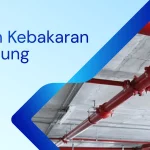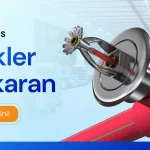Fire extinguishing systems in buildings are a vital part of modern building security systems. With the risk of fire occurring at any time, fire protection systems must be designed comprehensively and in accordance with safety standards.
This installation is not only intended to extinguish fires, but also to detect potential fires early on and organize a rapid response so that casualties and asset losses can be minimized.
This article discusses the three main types of systems that must be included in fire extinguishing installations in multi-story buildings.
3 Types of Mandatory Fire Extinguisher Installations in Buildings
Fire protection systems must include early detection, automatic extinguishing systems, and manual water supplies that are ready for use at any time. These three systems complement each other in providing comprehensive protection against fire risks.
Fire Alarm Systems in Buildings
The fire alarm system or Fire Alarm System is the first component that functions to automatically detect signs of fire.
This system uses various devices such as smoke detectors, heat detectors, and ventilation systems such as exhaust fans and intake fans connected to the alarm system.
Some buildings also integrate this system with elevators and other security devices to ensure smooth evacuation when the alarm sounds.
One of the advantages of this system is its ability to connect directly to the city's fire department. This means that in the event of a fire, the system can automatically send a signal to the authorities so that the response process can be carried out more quickly and efficiently.
Installing a fire alarm system in a building's fire extinguishing system is an essential first step in detecting hazards early on.
Fire Suppression Systems
Unlike alarm systems, Fire Suppression Systems are designed to automatically extinguish fires as soon as they are detected. These systems are particularly important in high-risk areas such as server rooms, electrical panels, or rooms where important archives are stored.
This system works using gases or chemicals that do not damage electronic and sensitive devices, such as FM200, Argonit, CO2, NOVEC 1230, and Inergen.
The fire suppression system is equipped with a temperature detector that will activate the extinguishing system when the room temperature exceeds the safe limit. The speed and effectiveness of this system make it a crucial part of the fire extinguishing installation in a building, especially to protect areas that should not be exposed to water or handled too late.
Hydrant
Fire Hydrant System is a manual fire extinguishing system that relies on a high-pressure water supply. This system consists of a network of pipes and hydrant valves that can be used by trained firefighters or building occupants. Water from the hydrant can be immediately channeled to the fire points through hoses and nozzles, providing a quick response when the fire starts to grow.
Hydrants are very important in fire extinguishing installations in buildings because they provide a stable source of water and can be used at various strategic points.
This system is also often used as the main backup when the automatic system fails or when the fire is beyond the control of the initial extinguishing equipment such as APAR (Light Fire Extinguisher).
The three systems above are mandatory components in fire extinguishing installations in high-rise buildings. Each system has a role and function that supports each other to ensure the safety of occupants and maximum protection of building assets.
In addition, the presence of APAR on each floor is also an important complement that allows extinguishing to be carried out at an early stage.
To ensure all of these systems are designed and installed to the highest standards, it is wise to work with an experienced contractor.
Adiwarna is present as a trusted fire protection contractor that is ready to assist in the installation of fire systems from planning to implementation, according to the needs and specifications of the building.







